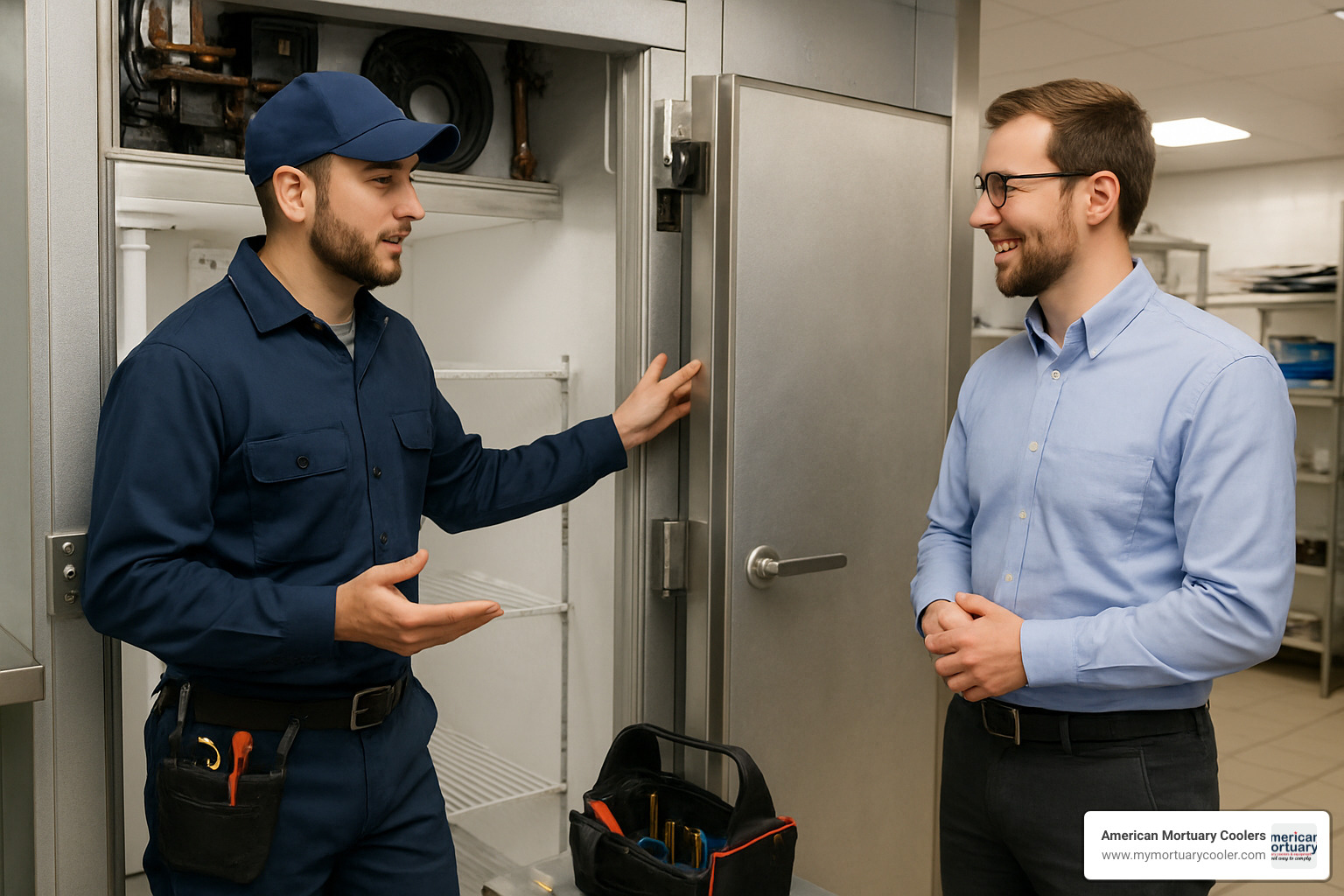Why Walk-In Cooler Repair Can't Wait
Walk-in cooler repair is critical for any business that relies on refrigeration to protect valuable inventory. When your cooling system fails, you need fast solutions to prevent product loss and business disruption.
Quick Answer: How to Get Fast Walk-In Cooler Repair
- Check the basics: Inspect power supply, thermostat settings, and door seals
- Call a local expert: Search for "commercial refrigeration repair near me" with good reviews
- Request same-day service: Most reputable companies offer emergency service
- Prepare information: Know your cooler brand, symptoms, and when the problem started
Walk-in coolers are the backbone of many businesses, from restaurants and grocery stores to pharmacies and funeral homes. When these critical systems malfunction, the consequences can be severe – thousands of dollars in spoiled inventory, health code violations, and business downtime.
According to industry data, the average cost to repair a walk-in freezer can range from $100 to $300, with compressor repairs costing significantly more. What's worse, if these issues are left unaddressed, they often lead to more expensive repairs down the road.
Regular maintenance, like cleaning condenser coils and checking door seals, can significantly extend your walk-in cooler's lifespan while reducing energy costs. However, even well-maintained units will eventually need professional attention.
I'm Mortuary Cooler, a national-level supplier of mortuary coolers with extensive experience providing walk-in cooler repair guidance to funeral homes and other commercial clients. My team has helped countless businesses diagnose and resolve refrigeration issues quickly to protect their valuable inventory.
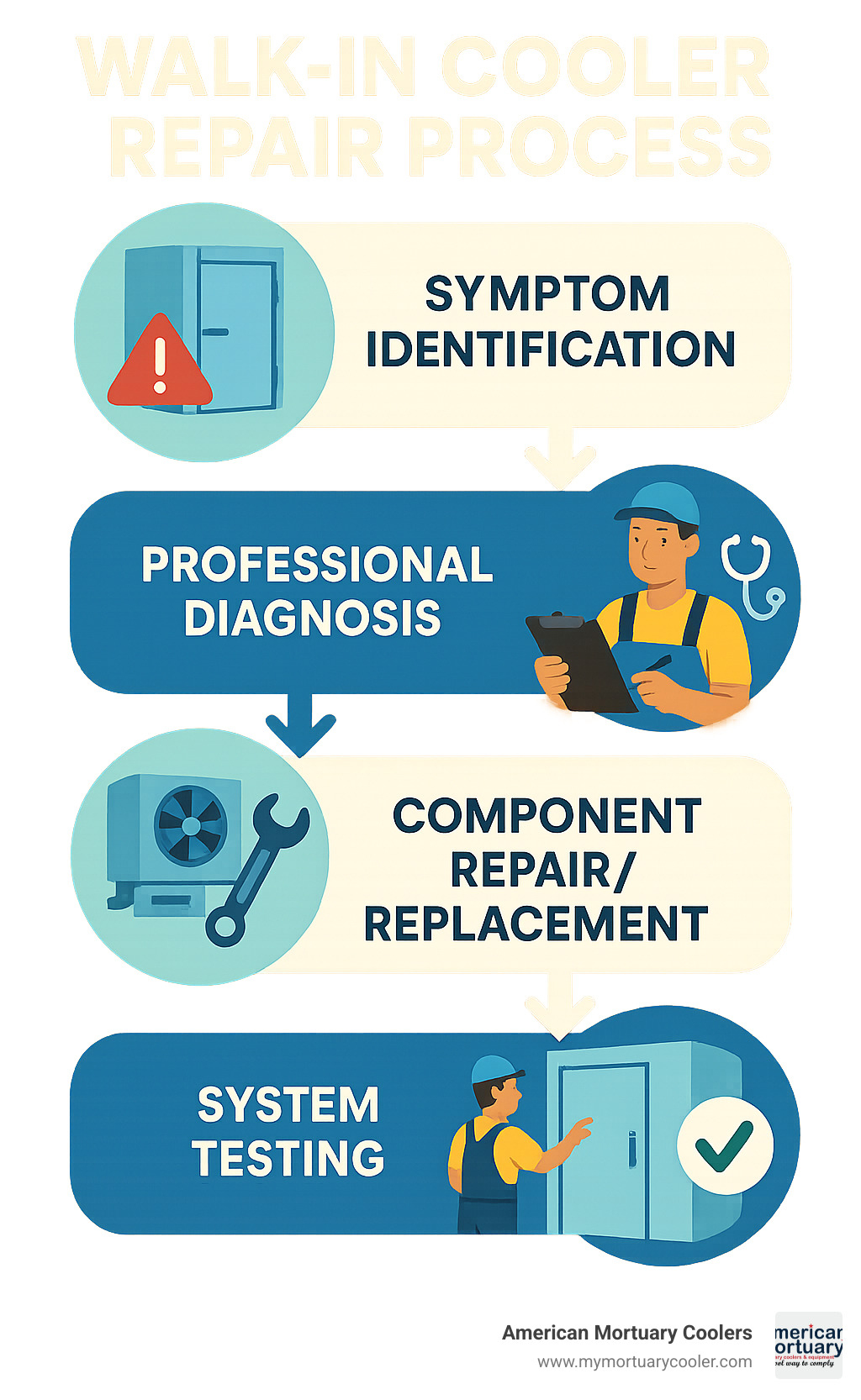
Why Walk-In Coolers Are Critical to Commercial Operations
Ever wonder what keeps your favorite restaurant's ingredients fresh or how pharmacies store temperature-sensitive medications? The humble walk-in cooler is the unsung hero behind countless businesses, silently protecting valuable inventory around the clock.
For food service establishments, these refrigeration systems aren't just convenient—they're essential guardians of food safety. That perfectly fresh salmon or delicate produce represents thousands of dollars of inventory that could spoil in hours without proper cooling. Pharmacies and medical facilities rely on precise temperature control to maintain the efficacy of medications and preserve biological samples. Even your local florist depends on walk-in coolers to extend the life of their beautiful but delicate blooms.
The financial stakes couldn't be higher. When a walk-in cooler fails, the consequences can be devastating. Imagine a mid-sized restaurant losing their entire inventory overnight—that's easily $10,000 or more gone in a flash. But the ripple effects go further: business interruption, disappointed customers, and potential reputation damage that lasts long after the temperatures rise.
Your bottom line feels the impact in another way too. Walk-in coolers are power-hungry appliances, and when they're not running efficiently, your utility bills tell the story. A struggling cooling system might add hundreds of dollars to your monthly expenses—money that could otherwise support your business growth.
Key Components That Keep Things Cold
Understanding the basic anatomy of your walk-in cooler helps you spot problems early and communicate more effectively with repair technicians. Think of these components as the vital organs of your cooling system:
The compressor functions as the heart of your refrigeration system, pumping refrigerant throughout the entire unit. When this critical component fails, cooling stops completely—and replacement often represents the most expensive repair you'll face.
Your condenser works like the cooling radiator in your car, releasing captured heat from inside the cooler to the outside environment. When condenser coils get clogged with dust and debris (a common issue), your system works overtime and cooling efficiency plummets.
Inside the cooler, the evaporator silently absorbs heat from the interior space. When you notice frost or ice building up on this component, it's your system's way of waving a red flag that something's wrong.
Modern walk-in coolers rely on sophisticated thermostat and control systems to maintain the precise temperatures your inventory requires. Even small malfunctions can cause dangerous temperature swings that put your products at risk.
Those rubber door gaskets might seem simple, but they're crucial for keeping cold air in and warm air out. Damaged seals force your entire system to work harder, dramatically increasing energy consumption and wear on other components.
Finally, the insulation panels making up the walls, ceiling, and floor of your walk-in cooler create the thermal barrier that maintains stable internal temperatures. When panels become damaged, efficiency suffers immediately.
When any of these components starts to fail, prompt walk-in cooler repair becomes essential. Waiting too long doesn't just risk your inventory—it often leads to cascading system failures that turn a simple fix into a major expense.
Top Signs Your Equipment Requires Walk-In Cooler Repair Fast
Is your walk-in cooler trying to tell you something? Just like we get warning signs when we're coming down with a cold, your refrigeration equipment sends signals when it needs attention. Catching these early can be the difference between a minor fix and a major catastrophe for your business.
Temperature inconsistency is often the first red flag. When your thermometer readings start dancing above your set point or swing wildly throughout the day, your cooling system is crying out for help. Even small fluctuations of a few degrees can put your inventory at risk and signal bigger problems brewing beneath the surface.
That winter wonderland forming inside your cooler? It's not a feature—it's a problem. Ice buildup on evaporator coils, walls, or ceilings is never normal operation. This frosty development typically points to airflow restrictions, refrigerant issues, or a defrost system that's given up the ghost.
Your ears can be just as important as your eyes when detecting trouble. Unusual noises like grinding, squealing, or rattling coming from your compressor or fans aren't just annoying—they're distress signals from mechanical components wearing out. As one technician told me, "If it sounds bad, it is bad, and it's only going to get worse."
Finding water puddles inside or around your walk-in cooler? That's another clear sign you need walk-in cooler repair soon. These leaks might indicate clogged drain lines, excessive ice melt from an inefficient system, or failing door seals letting warm, humid air infiltrate your cooled space.
Don't overlook your utility bills, either. A sudden spike in electricity costs without any change in your operation often means your cooler is working overtime due to developing mechanical issues. This extra energy consumption hits your bottom line twice—once on your utility bill and again when the overworked components fail prematurely.
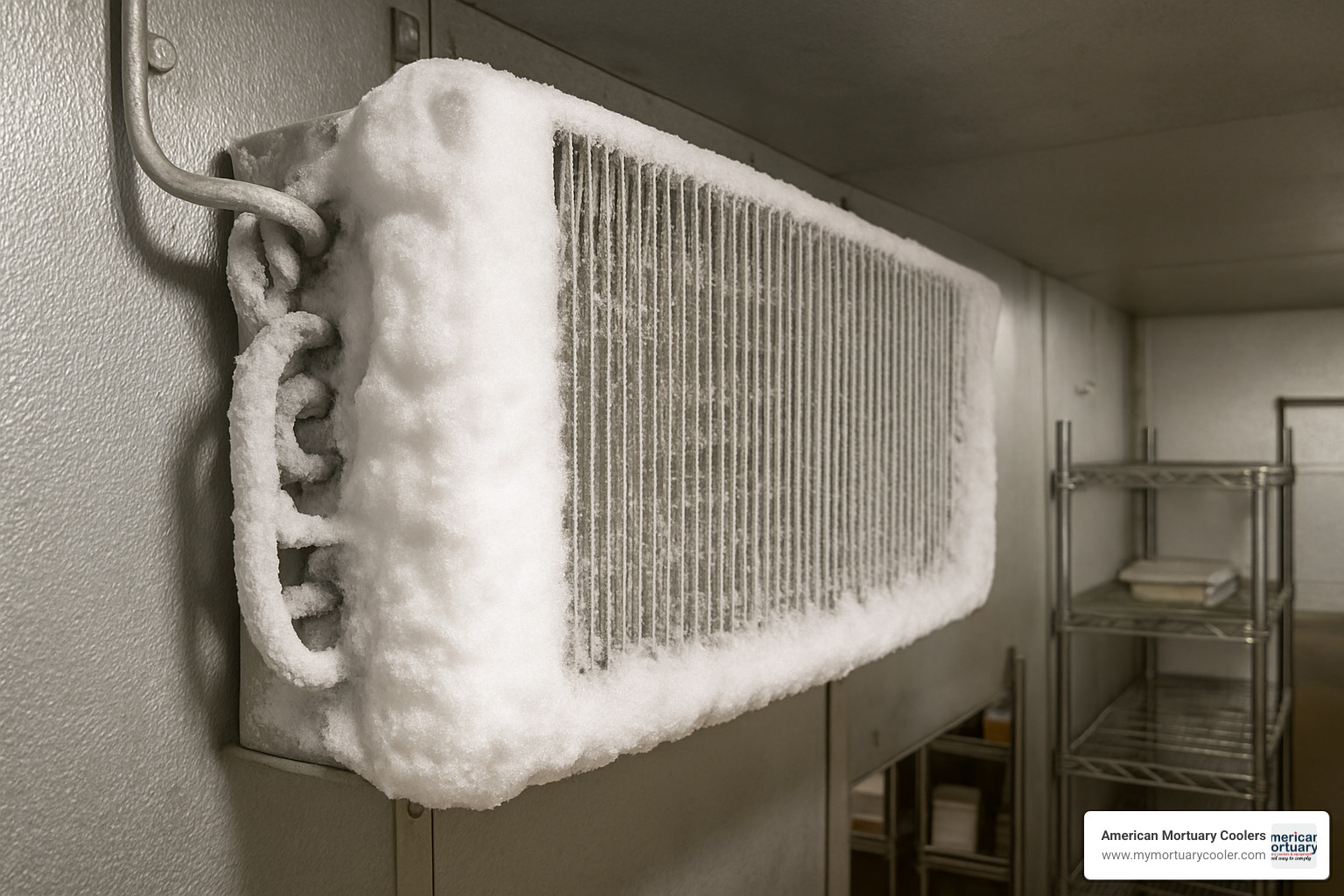
Walk-In Cooler Repair Red Flags You Can't Ignore
While some warning signs give you a grace period to schedule service, others demand immediate action. These aren't just warnings—they're emergencies:
When you find spoiled inventory despite your thermostat showing proper settings, you're already experiencing system failure. This isn't a "schedule for next week" situation—it's a "drop everything and call for help" moment.
A compressor that never stops running is like a car engine revving at maximum RPM non-stop. This constant motor running not only wastes energy but puts tremendous strain on your system's most expensive component. Without intervention, complete burnout is inevitable.
Modern walk-in coolers come equipped with sophisticated control systems that self-diagnose problems. When those control board alarms or error codes light up, they're not suggestions—they're urgent alerts designed to prevent catastrophic failure.
"By the time most businesses call for help, they've already ignored several warning signs," explains a veteran service technician with over 11 years in the field. "The difference between a $200 repair and a $2,000 repair is often just a matter of weeks."
Safety & Health Risks of Delayed Walk-In Cooler Repair
The stakes of postponing necessary walk-in cooler repair go beyond financial considerations—they extend to serious health and safety concerns.
Mold and mildew thrive in the perfect storm conditions created by a malfunctioning cooler: inconsistent temperatures and excess moisture. Once established, these contaminants can infiltrate inventory and create air quality issues that affect both products and people.
Even more concerning is the invisible threat of bacterial growth. Food items experiencing temperature abuse can develop harmful bacteria while showing no visible signs of spoilage, potentially leading to foodborne illness outbreaks. Industry data suggests that about 30% of such outbreaks trace back to temperature control failures in storage.
Regulatory agencies take cold storage seriously. Health departments, OSHA, and the FDA maintain strict requirements for temperature maintenance. Violations resulting from malfunctioning equipment can lead to fines, business closures, or product recalls that damage both your finances and reputation.
Your staff's wellbeing is also at stake. Leaking refrigerant, electrical issues from moisture exposure, or treacherous ice buildup create workplace hazards for anyone accessing the cooler. A functioning cooling system isn't just about protecting products—it's about protecting people too.
Prompt attention to warning signs isn't just good business practice—it's an essential part of responsible operation in any industry that relies on refrigeration.
DIY Troubleshooting & Preventative Maintenance Checklist
Let's face it – your walk-in cooler is too important to ignore until something breaks. With a little hands-on attention, you can catch small issues before they become expensive emergencies. Here's how you can become your cooler's first line of defense:
When it comes to basic maintenance, condenser coil cleaning should be at the top of your list. Those dusty, dirty coils prevent proper heat transfer, making your system work overtime. Simply turn off power to the unit, locate the condenser (usually outside the cooler or on top), and gently clean with a soft brush, vacuum, or appropriate coil cleaner. Just be sure to follow your manufacturer's specific guidelines.
Want a simple test to check your door seals? Try the dollar bill test. Close the door on a dollar bill at various points around the frame. If you can pull it out easily without resistance, those gaskets need adjustment or replacement. This five-minute check can save you hundreds in energy costs.
Those puddles inside your cooler? They might be from a clogged drain line preventing proper water removal during defrost cycles. Locating and flushing the drain line with warm water can solve this common issue before it creates bigger problems.
For those with systems featuring a sight glass, take a peek occasionally. Bubbles or discoloration might indicate refrigerant issues – though remember, actual refrigerant work requires certified professionals with proper licensing.
One of the most valuable habits you can develop is maintaining a daily temperature log. This simple practice helps identify subtle patterns or gradual changes that might indicate developing problems long before they become obvious failures.
| Maintenance Task | DIY Appropriate? | Professional Service? | Frequency |
|---|---|---|---|
| Visual inspection | Yes | No | Daily |
| Temperature logging | Yes | No | Daily |
| Door gasket cleaning | Yes | No | Weekly |
| Condenser coil cleaning | Yes, with caution | Yes, recommended | Monthly |
| Evaporator cleaning | Limited | Yes, recommended | Quarterly |
| Refrigerant checks | No | Yes, required | Bi-annually |
| Electrical component inspection | No | Yes, required | Annually |
Step-by-Step Guide to Basic Walk-In Cooler Repair Checks
Before calling in the pros for walk-in cooler repair, here are some basic checks that might save you a service call:
Is your thermostat telling the truth? Use a separate calibrated thermometer to verify the actual cooler temperature and compare it with what's displayed. If there's more than a 2°F difference, your thermostat may need calibration or replacement.
Your fans should be seen and not heard – at least not making unusual noises. Take a moment to listen to your evaporator and condenser fans. Check for visible obstructions around the blades, verify the airflow is strong and consistent, and clean any dust from the guards.
Don't overlook those hardworking door hinges. Tighten any loose screws, add a touch of food-grade lubricant to keep things moving smoothly, and adjust door closers to ensure complete closure every time. Proper alignment ensures those gaskets make full contact all the way around.
While you're playing detective, look for oil stains around refrigeration components (a possible sign of refrigerant leaks), check for water pooling inside or outside the unit, inspect drain pans for proper drainage, and note any unusual odors that might indicate refrigerant issues.
Remember though – while these checks can help identify problems, leave the actual refrigerant handling, electrical work, and component replacement to certified professionals. Some repairs require specialized tools and training for safety and legal reasons.
How Often Should You Service Your Walk-In Cooler?
The key to avoiding costly emergency walk-in cooler repair is establishing a regular maintenance rhythm:
Daily checks should become second nature – a quick glance at temperatures, door operation, and interior cleanliness takes just minutes but provides invaluable peace of mind.
Weekly attention to door gaskets and listening for unusual noises or spotting ice buildup can catch developing issues early.
Monthly is when you'll want to clean those condenser coils, check drain lines, and inspect for any leaks.
Quarterly maintenance should include more thorough cleaning of all accessible components and lubricating moving parts.
Bi-annual professional service visits ensure comprehensive inspection and preventative maintenance by trained eyes.
Annual complete system evaluations should include electrical components, refrigerant levels, and efficiency testing.
As one of our trusted refrigeration partners often says, "The most expensive repair is the one you could have prevented with basic maintenance." Professional technicians should inspect commercial coolers at least twice yearly – a preventative approach that typically costs far less than emergency repairs while significantly extending your equipment's lifespan.
For a complete overview of maintenance best practices, check out our Walk-In Cooler Maintenance Checklist for Peak Performance.
Choosing Local Experts for Walk-In Cooler Repair
When your maintenance efforts just aren't cutting it anymore, finding the right professional for walk-in cooler repair becomes your top priority. Think of it like finding a good doctor – you want someone who specializes in exactly what you need.
Local refrigeration experts bring something special to the table that the big national chains often can't match. They typically offer faster response times (sometimes within hours instead of days), understand how your regional climate affects cooling performance, and often provide more personalized service at competitive rates. Plus, they're invested in building relationships in their community – your satisfaction directly impacts their local reputation.
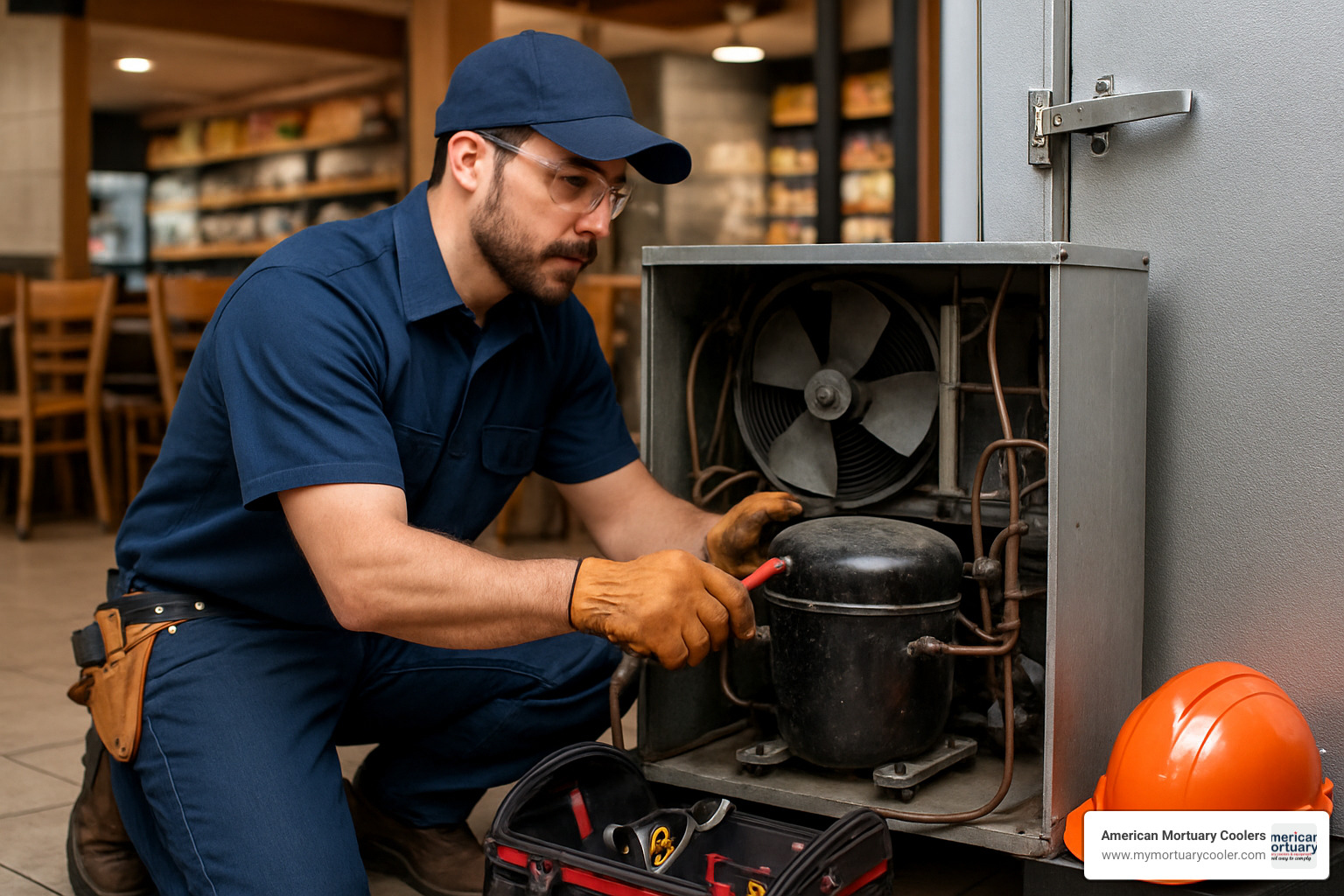
When searching for your refrigeration hero, look for these critical qualifications:
Specialized Experience in commercial refrigeration (not just residential AC). Commercial walk-in systems are a different animal altogether, and you need someone who speaks their language.
Proper Credentials matter tremendously – EPA certification for handling refrigerants isn't just nice to have, it's legally required. State licensing and manufacturer certifications show they've invested in their expertise.
24/7 Emergency Response because let's face it – coolers don't politely wait until business hours to break down. The best technicians understand that every hour of downtime costs you money.
Well-Stocked Service Vehicles can be the difference between a one-visit fix and days of waiting for ordered parts. Ask potential companies if their trucks carry common components for your system.
Clear Warranty Terms in writing show confidence in their work. A company that stands firmly behind their repairs with parts and labor guarantees is usually one you can trust.
As one local service manager with 15 years in the business told us, "We know our customers by name, and we know their systems inside and out. That history lets us diagnose problems faster and often spot potential issues before they become emergencies."
Questions to Ask Before Hiring for Walk-In Cooler Repair
Before you commit to a service provider, have a quick conversation and ask these revealing questions:
"Are your technicians EPA-certified and properly licensed for commercial refrigeration in our state?" This is non-negotiable for legal and safety reasons.
"What experience do you have with our specific brand of walk-in cooler?" Ideally, they've worked extensively on your exact model.
"Do you offer maintenance contracts with priority scheduling?" Companies that value preventative care often provide better emergency service too.
"What are your emergency response times and after-hours fees?" Know what to expect before you're in crisis mode at 2 AM.
"Will I receive a detailed written estimate before work begins?" This protects both parties and prevents surprise bills.
"What warranty covers your parts and labor?" Longer warranties often indicate higher quality work and parts.
"Can you provide references from similar businesses?" A confident provider will happily connect you with satisfied customers.
"Do your trucks carry common replacement parts for same-day repairs?" This can dramatically reduce your downtime.
The answers you receive will quickly separate the professionals from those you might want to avoid. Trust your instincts – if something feels off, keep looking.
Brands & Systems Most Technicians Can Handle
Most qualified refrigeration pros can comfortably service popular walk-in cooler brands including True, Turbo Air, Hoshizaki, Arctic Air, Beverage Air, Manitowoc, Traulsen, Copeland compressors, Montague, and Norlake.
Here's an industry secret worth knowing: despite the various brand names you'll see on cooler exteriors, many systems use similar internal components from just a handful of major manufacturers. This means a truly qualified technician should be able to service most standard systems, even if they don't specifically advertise your particular brand.
Custom-built systems or units with proprietary components present a different challenge. If you have a specialized unit (like those often found in mortuaries or medical facilities), ask potential service providers about their experience with similar systems before scheduling. Some might need to order specific parts that only the manufacturer can provide.
For more detailed guidance on finding reliable service providers, our article on Walk-In Cooler Service 101: Find Reliable Repair Providers provides additional insights. And if you're interested in the science behind proper maintenance, check out this scientific research on condenser maintenance that explains why regular upkeep is so critical.
Cost Factors, Repair vs. Replace, and Efficiency Upgrades
Let's talk money – because when your walk-in cooler starts acting up, your wallet is probably the first thing that comes to mind after your inventory concerns.
Most basic walk-in cooler repair jobs will run you between $100-$300, which typically covers those everyday fixes like thermostat issues or minor component replacements. When you're dealing with something more serious, especially compressor problems, be prepared to shell out $1,000 or more. Think of the compressor as the heart of your system – and heart surgery is never cheap!
What impacts these costs? Several things: how old your unit is, whether parts are readily available (older models can be tricky), labor rates in your area, and whether you're calling at 2 PM on a Tuesday or 2 AM on a holiday weekend. Emergency service always commands a premium, which is why having a maintenance relationship with a reliable provider can save you money in the long run.
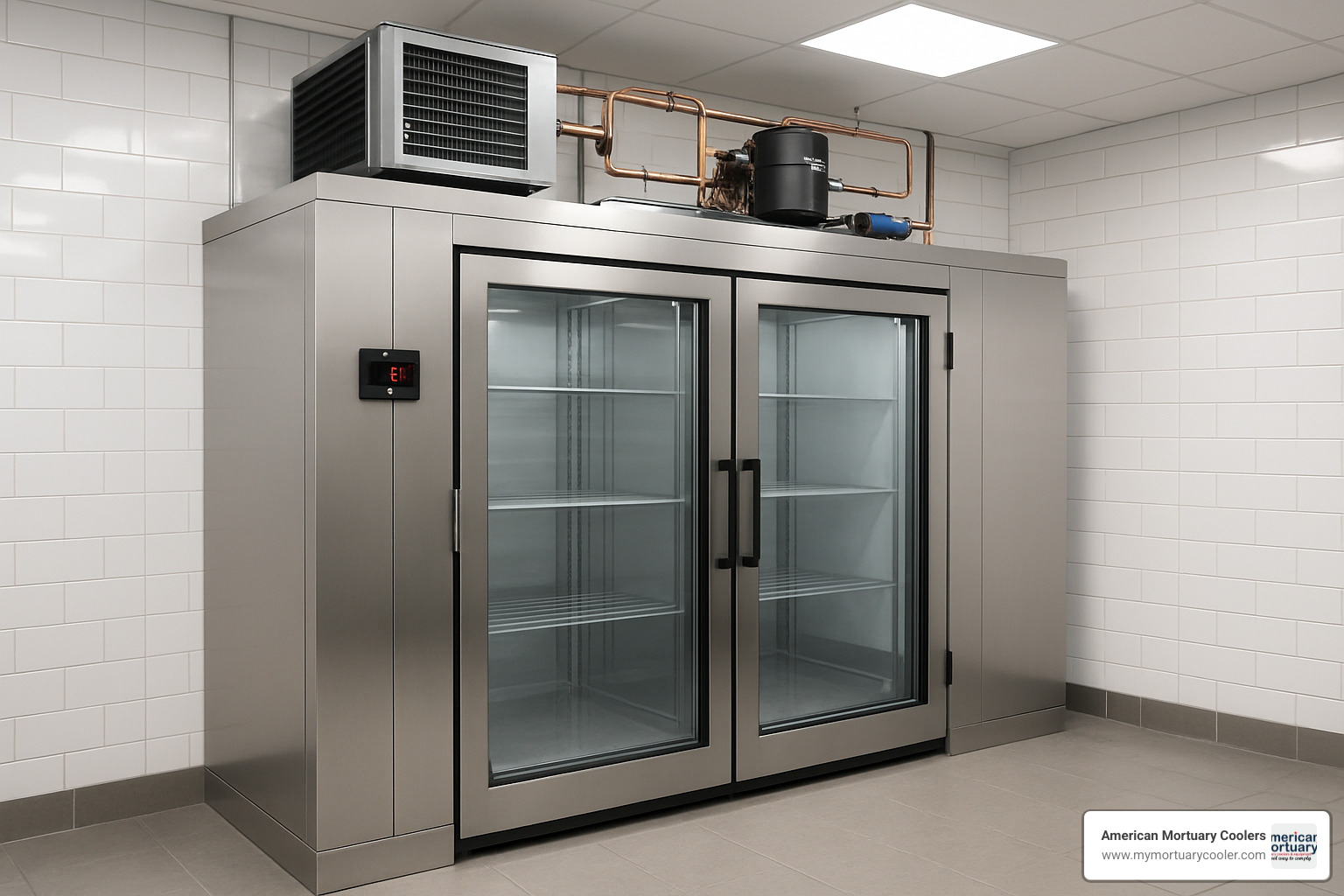
I've had many conversations with business owners facing the repair-or-replace dilemma. The industry rule of thumb is pretty straightforward: if your unit is over 10 years old and repairs will cost more than half of a new unit, replacement often makes more sense. As one technician told me with a chuckle, "Putting expensive parts in an old cooler is like putting premium gas in a car that's about to die – you're just making an expensive goodbye."
This is especially true if your system uses refrigerants being phased out by environmental regulations. R-22 (Freon) has been phased out since 2020, making it increasingly expensive and harder to find. Why pour money into a system that's fighting against regulatory headwinds?
When Replacement Beats Walk-In Cooler Repair
There are some clear signs that it's time to say goodbye to your old unit:
If your compressor has been replaced multiple times in recent years, something else is likely wrong with the system. It's like replacing the same light bulb every month – the problem probably isn't the bulb.
Structural panel damage is another deal-breaker. Those insulated panels are what make your cooler a cooler. When they're compromised by water damage, impacts, or just age, they can harbor mold and lose efficiency. At that point, patching things up is usually throwing good money after bad.
Using outdated refrigerant is a major consideration too. One business owner told me they were quoted $800 for R-22 refrigerant alone during a recent repair – nearly double what it would have cost with modern refrigerants. That's money you'll never recover through efficiency.
And if your unit constantly struggles to maintain proper temperatures despite repairs, it might be undersized for your current needs or suffering from multiple issues that are hard to pinpoint individually.
Tips to Boost Performance While Cutting Utility Bills
Whether you decide to repair or replace, there are ways to improve performance and reduce those monthly utility bills that make you wince:
LED lighting conversions are one of the easiest upgrades with multiple benefits. They use less electricity, produce less heat (meaning your cooler doesn't have to work as hard), and typically last much longer than fluorescent fixtures.
Smart monitoring systems can be real lifesavers. They alert you to temperature problems before they destroy inventory and provide valuable usage data to help optimize performance. One restaurant owner told me a smart system saved $12,000 worth of food when it alerted him to a failing compressor at 3 AM.
Strip curtains or air curtains dramatically reduce the warm air that enters when doors are opened. They're inexpensive, easy to install, and can reduce energy usage by 5-10%.
Optimizing defrost cycles based on your actual usage patterns rather than factory settings can cut energy use by 10-15%. Most units defrost more frequently than necessary.
ECM fan motors use up to 70% less energy than standard motors while generating less heat. They're more expensive upfront but usually pay for themselves within a year or two.
Door closers and alarms prevent one of the most common energy wasters – doors left ajar. We're all human, and in a busy environment, it's easy to forget to fully close the door.
The best part? Many utility companies offer substantial rebates for these energy-efficient upgrades. I've seen businesses cover 30-50% of upgrade costs through local utility incentives. Check out programs in your area that might cover LED conversions, motor upgrades, door gasket replacements, or control system improvements.
As one refrigeration efficiency expert told me, "Most businesses can slash their walk-in cooler energy consumption by a third with targeted upgrades that pay for themselves in under two years." That's money in your pocket month after month, year after year.
For more details on what affects pricing for walk-in coolers, check out our guide on Decoding Walk-In Cooler Pricing Factors.
Frequently Asked Questions About Walk-In Cooler Repair
What is the average cost of walk-in cooler repair?
When your walk-in cooler starts acting up, cost is probably one of your first concerns. Most walk-in cooler repair jobs for smaller issues like replacing a thermostat, adjusting doors, or fixing fans typically run between $100 and $300. But let's be honest – when the compressor goes or you're dealing with refrigerant system problems, you're looking at $1,000 or more.
And yes, that midnight emergency call will cost you – expect to pay 1.5 to 2 times the normal rate when you need help outside regular business hours. That's just the reality of urgent service.
What affects these prices? Several things come into play: the specific part that needs fixing, how old your unit is, where your business is located, whether you need immediate help or can schedule ahead, and how easy (or difficult) it is for technicians to access your unit.
Here's a money-saving tip from our experience: consider setting up a service contract with a reliable local provider. These agreements often include priority scheduling when problems arise and discounted rates for both routine maintenance and those inevitable repairs. It's like having insurance for your cooling system.
How long should a commercial walk-in cooler last?
With proper care, your commercial walk-in cooler should serve your business reliably for 10-15 years before major components start giving out. The actual structure – the panels and doors – can last even longer, often 15-20 years or more.
The working parts inside have their own timelines:
- Compressors typically last 8-10 years
- Fans for evaporators and condensers usually go 5-10 years
- Control systems generally work well for 7-12 years
- Door gaskets need replacement every 2-3 years
I've seen this in the field. As one technician told me, "I've serviced walk-in coolers that are over 20 years old and still running efficiently because their owners invested in preventative maintenance and addressed minor issues promptly."
The flip side is also true – neglected systems often fail in just 5-7 years. The culprits? Dirty condenser coils that make compressors overheat, unaddressed refrigerant leaks, worn-out door seals that make the system work overtime, and poor installation from the start.
Regular maintenance isn't just a recommendation – it's the difference between replacing your system in 7 years versus 17 years.
Can I use generic parts for walk-in cooler repair?
The generic parts question comes up in almost every walk-in cooler repair situation, and the answer isn't simply yes or no – it depends on the part and your priorities.
Generic or "universal" parts typically cost 20-40% less than original manufacturer parts, which is certainly appealing when you're facing repair bills. They're often more readily available, especially when the original parts are discontinued or on backorder. And in an emergency, that availability can be the difference between reopening tomorrow or being closed for days.
But there are real tradeoffs. Generic parts may not last as long, could potentially void your manufacturer's warranty, and sometimes cause compatibility issues that affect performance. In the worst cases, an ill-fitting generic part can cause a cascade of other failures.
For critical components that manage refrigerant flow or pressure control – like compressors, control boards, and expansion valves – manufacturer-specified parts generally provide better reliability and performance. It's worth the extra cost.
For less critical items like fan motors, door gaskets, and some electrical components, quality aftermarket parts from reputable suppliers often represent good value without compromising your system's integrity.
As a seasoned refrigeration technician once told me, "If the component affects refrigerant flow or pressure control, stick with OEM parts. For peripheral components, quality aftermarket parts from reputable suppliers are usually fine."

Conclusion
When your commercial refrigeration system fails, finding fast, reliable walk-in cooler repair becomes your top priority. The stress of a malfunctioning cooler can keep any business owner up at night, but with the right approach, you can minimize downtime and protect your valuable inventory.
Think of your walk-in cooler maintenance like caring for your car – regular check-ups prevent breakdowns on the highway. By understanding warning signs and building relationships with qualified service providers before emergencies happen, you'll be prepared when issues inevitably arise.
Remember these key points as you manage your refrigeration systems:
Act quickly when you notice the first signs of trouble. Those temperature fluctuations, unusual noises, or frost buildup aren't just minor annoyances – they're your system's way of asking for help before a complete breakdown occurs.
Regular maintenance isn't just a suggestion – it's essential protection for your business. Simple tasks like cleaning coils, checking door seals, and scheduling professional inspections can prevent those middle-of-the-night emergency calls that wreck your budget.
Local refrigeration specialists who understand your equipment become invaluable partners in keeping your business running smoothly. Take time to find technicians who respond promptly, communicate clearly, and stand behind their work.
Think long-term when facing repair decisions. Sometimes the cheaper fix today leads to more expensive problems tomorrow. Consider energy efficiency improvements, upcoming refrigerant regulations, and the age of your equipment when deciding between repair and replacement.
Keep detailed records of all maintenance activities and repairs. This documentation helps technicians diagnose issues more efficiently and gives you insight into your system's performance patterns over time.
At American Mortuary Coolers, we understand the critical nature of refrigeration systems across multiple industries. While our specialty is crafting custom mortuary coolers delivered directly to funeral homes nationwide, we've seen how proper refrigeration maintenance and repair principles apply universally.
Whether you're preserving food inventory, medical supplies, floral arrangements, or providing dignified care in the funeral industry, your refrigeration system deserves attention and care. When in doubt, always consult with qualified local professionals who can provide hands-on expertise custom to your specific equipment and needs.
